Exploring the Connections between Agroecological Practices and Ecosystem Services: A Systematic Literature Review
Abstract
1. Introduction
2. Materials and Methods
2.1. Literature Review and Data Collection
2.2. Data Analysis
3. Results
3.1. Status and General Trends of the Research on Agroecological Practices and Ecosystem Services
3.2. Linkages between Agroecological Practices and Ecosystem Services
3.3. Sets of Agroecological Practices Affecting Ecosystem Services
4. Discussion
4.1. Research Gaps and Biases: Insights for Future Research
4.2. Relationships between Agroecological Practices and Ecosystem Services
4.3. Management Implications of the Agroecological Transition
Supplementary Materials
Author Contributions
Funding
Acknowledgments
Conflicts of Interest
Appendix A
| Keywords | |
|---|---|
| Sustainable management | “Agricult* transition” OR “Agroecolog*” OR “Alternative agricult*” OR “Alternative farm*” OR “Alternative Product*” OR “Biodiversity-based agricult*” OR “Biodiversity-based farm*” OR “Biodiversity-based product*” OR “Bio-dynamic agricult*” OR “Bio-dynamic farm*” OR “Biodynamic agricult*” OR “Biodynamic farm*” OR “Conservation agricult*” OR “Conservation farm*” OR “Conservation product*” OR “Diversified agricult*” OR “Diversified farm*” OR “Diversified product*” OR “Ecoagricult*” OR “Ecofarm*” OR “Eco-functional intensification” OR “Ecologically intensive agricult*” OR “Ecologically intensive farm*” OR “Ecologically intensive product*” OR “Environment* sensitive agricult*” OR “Environment* sensitive farm*” OR “Environment* sensitive product*” OR “Farm* transition” OR “Integrated agricult*” OR “Integrated farm*” OR “Integrated product*” OR “Low-input agricult*” OR “Low-input farm*” OR “Low-input product*” OR “Multifunctional agricult*” OR “Multifunctional farm*” OR “Natural agricult*” OR “Natural farm*” OR “Natural product*” OR “Organic agricult*” OR “Organic farm*” OR “Organic product*” OR “Permacultur*” OR “Social agricult*” OR “Social farm*” OR “Sustainable agricult*” OR “Sustainable farm*” OR “Sustainable product*” |
| Ecosystem services’ framework | “Agricult* services” OR “Cultural service*” OR “Ecosystem* function” OR “Ecosystem* good*” OR “Ecosystem* service*” OR “Environmental service*” OR “Environmental good*” OR “Farm* service*” OR “Natur* service*” OR “Provisioning service*” OR “Regulating service*” |
| Ecosystem services | “Biofuel*” OR “Fiber*” OR “Fibre*” OR “Fodder” OR “Food” OR “Fuel” OR “Genetic material*” OR “Genetic resource*” OR “Medicinal resource*” OR “Ornamental resource*” OR “Raw material*” OR “Air flow regulation” OR “Air purificat*” OR “Air quality regulation” OR “Atmospheric regulation” OR “Biocontrol” OR “Biologic* control” OR “Biologic* pest control” OR “Biorremediat*” OR “Carbon emission*” OR “Carbon loss” OR “Carbon sequest*” OR “Carbon storage” OR “Climate regulation” OR “Disease control” OR “Erosion control” OR “Erosion prevention” OR “Erosion protection” OR “Habitat for species” OR “Habitat maintentace” OR “Habitat provision” OR “Hazard prevention” OR “Hazard regulation” OR “Natural pest control” OR “Nutrient* cycling” OR “Nutrient* regulation” OR “Pest control” OR “Plague control” OR “Plague prevention” OR “Pollination service*” OR “Pollination” OR “Pollinator* efficiency” OR “Pollinator*” OR “Sediment retention” OR “Seed dispers*” OR “Soil cycle regulation” OR “Soil erosion” OR “Soil fertility” OR “Soil formation” OR “Soil loss prevention” OR “Soil regulation” OR “Soil stability” OR “Waste treatment” OR “Water flow maintenance” OR “Water flow regulation” OR “Water purification” OR “Water quality” OR “Water regulation” OR “Aesthetic service*” OR “Aesthetic value” OR “Beauty” OR “Cultural heritage” OR “Cultural value*” OR “Ecological knowledge” OR “Educat* knowledge” OR “Environment* educat*” OR “Experience of natur*” OR “Ex-situ viewing” OR “Heritage” OR “Identity” OR “Inspiration” OR “Landscape beauty” OR “Local ecological knowledge” OR “Local knowledge” OR “Recreat*” OR “Relax” OR “Scenic beaut*” OR “Scientific knowledge” OR “Sense of place” OR “Touris*” OR “Traditional ecological knowledge” OR “Tranquility” OR “Turis*” |
Appendix B
| Scores | Squared Cosines | |||
|---|---|---|---|---|
| F1 | F2 | F1 | F2 | |
| Fodder | −0.180 | 0.091 | 0.396 | 0.102 |
| Food | −0.313 | 0.037 | 0.788 | 0.011 |
| Pest control | 0.816 | −0.429 | 0.777 | 0.215 |
| Carbon sequestration | −0.079 | −0.046 | 0.136 | 0.047 |
| Erosion protection | 0.010 | −0.003 | 0.007 | 0.001 |
| Soil fertility | −0.673 | −0.130 | 0.792 | 0.033 |
| Climate regulation | −0.041 | −0.068 | 0.052 | 0.141 |
| Water flow regulation | −0.116 | −0.002 | 0.195 | 0.000 |
| Pollination | 0.590 | 0.494 | 0.572 | 0.401 |
| Aesthetic value | −0.050 | 0.056 | 0.067 | 0.086 |
| Scores | ||
|---|---|---|
| F1 | F2 | |
| No/natural fertilizers | −0.024 | −0.042 |
| No/natural pesticides | 0.024 | −0.055 |
| No/natural herbicides | −0.021 | −0.027 |
| No/light tillage | −0.049 | −0.062 |
| Crop rotations | −0.182 | 0.050 |
| Field margins/buffer strips | 0.179 | 0.169 |
| Complex landscapes | 0.244 | 0.037 |
| Cover crops | 0.112 | −0.137 |
| Livestock combination | −0.095 | 0.039 |
| Crop diversification | −0.082 | 0.066 |
| Residue retention on soil | −0.142 | 0.057 |
References
- Asner, G.P.; Elmore, A.J.; Olander, L.P.; Martin, R.E.; Harris, A.T. Grazing systems, ecosystem responses, and global change. Annu. Rev. Environ. Resour. 2004, 29, 261–299. [Google Scholar] [CrossRef]
- The World Bank. Agricultural Land (% of Land Area). Available online: https://data.worldbank.org/indicator/AG.LND.AGRI.ZS?end=2015&start=1961 (accessed on 6 June 2018).
- Borlaug, N.E. The Green Revolution: For bread and peace. Bull. Atom. Sci. 1971, 27, 6–48. [Google Scholar] [CrossRef]
- Matson, P.A.; Parton, W.J.; Power, A.G.; Swift, M.J. Agricultural intensification and ecosystem properties. Science 1997, 277, 504. [Google Scholar] [CrossRef] [PubMed]
- Tilman, D. Global environmental impacts of agricultural expansion: The need for sustainable and efficient practices. Proc. Natl. Acad. Sci. USA 1999, 96, 5995–6000. [Google Scholar] [CrossRef] [PubMed]
- Green, R.E.; Cornell, S.J.; Scharlemann, J.P.W.; Balmford, A. Farming and the fate of wild nature. Science 2005, 307, 550–555. [Google Scholar] [CrossRef] [PubMed]
- Tscharntke, T.; Clough, Y.; Wanger, T.C.; Jackson, L.; Motzke, I.; Perfecto, I.; Vandermeer, J.; Whitbread, A. Global food security, biodiversity conservation and the future of agricultural intensification. Biol. Conserv. 2012, 151, 53–59. [Google Scholar] [CrossRef]
- Amanor, K.S. The new frontier: Farmer’s response to land degradation-A West African study. In Revisiting Sustainable Development, 1st ed.; United Nations Research Institute for Social Development (UNRISD): Geneva, Switzerland, 2015; p. 180. ISBN 978-9-290-85094-6. [Google Scholar]
- United Nations Research Institute for Social Development. Social development and the International Development Strategy. In Revisiting Sustainable Development, 1st ed.; United Nations Research Institute for Social Development (UNRISD): Geneva, Switzerland, 2015; p. 19. ISBN 978-9-290-85094-6. [Google Scholar]
- Pearse, A. Seeds of plenty, seeds of want: Social and economic implications of the Green Revolution. In Revisiting Sustainable Development, 1st ed.; United Nations Research Institute for Social Development (UNRISD): Geneva, Switzerland, 2015; pp. 160, 174. ISBN 978-9-290-85094-6. [Google Scholar]
- Therond, O.; Duru, M.; Roger-Estrade, J.; Richard, G. A new analytical framework of farming system and agriculture model diversities. A review. Agron. Sustain. Dev. 2017, 37, 21. [Google Scholar] [CrossRef]
- United Nations, Department of Economic and Social Affairs, Population Division. World Population Prospects: The 2015 Revision, Key Findings and Advance Tables, 2015 (Working Paper No. ESA/P/WP.241). Available online: https://www.popline.org/node/639412 (accessed on 19 November 2018).
- Kremen, C.; Miles, A. Ecosystem services in biologically diversified versus conventional farming systems: Benefits, externalities, and trade-offs. Ecol. Soc. 2012, 17, 40. [Google Scholar] [CrossRef]
- Borlaug, N. Ending world hunger. The promise of biotechnology and the threat of antiscience zealotry. Plant. Physiol. 2000, 124, 487–490. [Google Scholar] [CrossRef] [PubMed]
- Phipps, R.H.; Park, J.R. Environmental benefits of genetically modified crops: Global and European perspectives on their ability to reduce pesticide use. J. Anim. Feed. Sci. 2002, 11, 1–18. [Google Scholar] [CrossRef]
- Godfray, H.C.J.; Beddington, J.R.; Crute, I.R.; Haddad, L.; Lawrence, D.; Muir, J.F.; Pretty, J.; Robinson, S.; Thomas, S.M.; Toulmin, C. Food security: The challenge of feeding 9 billion people. Science 2010, 327, 812–818. [Google Scholar] [CrossRef] [PubMed]
- Tester, M.; Langridge, P. Breeding technologies to increase crop production in a changing world. Science 2010, 327, 818–822. [Google Scholar] [CrossRef] [PubMed]
- Tilman, D.; Cassman, K.G.; Matson, P.A.; Naylor, R.; Polasky, S. Agricultural sustainability and intensive production practices. Nature 2002, 418, 671–677. [Google Scholar] [CrossRef] [PubMed]
- Jackson, L.E.; Pascual, U.; Hodgkin, T. Utilizing and conserving biodiversity in agricultural landscapes. Agric. Ecosyst. Environ. 2007, 121, 196–210. [Google Scholar] [CrossRef]
- Scherr, S.; McNeely, J.A. Biodiversity conservation and agricultural sustainability: Towards a new paradigm of “ecoagriculture” landscapes. Phil. Trans. R. Soc. 2008, 363, 477–494. [Google Scholar] [CrossRef] [PubMed]
- Perfecto, I.; Vandermeer, J. The agroecological matrix as alternative to the land-sparing/agriculture intensification model. Proc. Natl. Acad. Sci. USA 2010, 107, 5786–5791. [Google Scholar] [CrossRef] [PubMed]
- Altieri, M.A.; Funes-Monzote, F.R.; Petersen, P. Agroecologically efficient agricultural systems for smallholder farmers: Contributions to food sovereignity. Agron. Sustain. Dev. 2012, 32, 1–13. [Google Scholar] [CrossRef]
- Wezel, A.; Bellon, S.; Doré, T.; Francis, C.; Vallod, D.; David, C. Agroecology as a science, a movement and a practice. Agron. Sustain. Dev. 2009, 29, 503–515. [Google Scholar] [CrossRef]
- Altieri, M.A. Agroecology: The Science of Sustainable Agriculture, 2nd ed.; CRC Press: Boca Raton, FL, USA, 1995; ISBN 9780429964015. [Google Scholar]
- Altieri, M.A. Agroecology: The science of natural resource management for poor farmers in marginal environments. Agric. Ecosyst. Environ. 2002, 93, 1–24. [Google Scholar] [CrossRef]
- Francis, C.; Lieblein, G.; Gliessman, S.; Breland, T.A.; Creamer, N.; Harwood, R.; Salomonsson, L.; Helenius, J.; Rickerl, D.; Salvador, R.; et al. Agroecology: The ecology of food systems. J. Sustain. Agric. 2003, 22, 99–118. [Google Scholar] [CrossRef]
- Gliessman, S. Agroecology: Growing the roots of resistance. Agroecol. Sustain. Food Syst. 2013, 37, 19–31. [Google Scholar]
- Gliessman, S. Defining agroecology. Agroecol. Sustain. Food Syst. 2018, 42, 599–600. [Google Scholar] [CrossRef]
- Migliorini, P.; Wazel, A. Converging and diverging principles and practices of organic agriculture regulations and agroecology. A review. Agron. Sustain. Dev. 2017, 37, 63. [Google Scholar] [CrossRef]
- FAO. Agroecology for food security and nutrition. In Proceedings of the FAO International Symposium, Rome, Italy, 18–19 September 2014; FAO: Rome, Italy, 2015. [Google Scholar]
- FAO. Food and Agriculture: Driving Action Across the 2030 Agenda for Sustainable Development. Available online: http://www.fao.org/3/a-i7454e.pdf (accessed on 13 June 2018).
- FAO. The 10 elements of Agroecology: Guiding the Transitions to Sustainable Food and Agricultural Systems. Available online: http://www.fao.org/3/I9037EN/i9037en.pdf (accessed on 13 June 2018).
- Milan Urban Food Policy Pact. Available online: http://www.milanurbanfoodpolicypact.org/wp-content/uploads/2016/06/Milan-Urban-Food-Policy-Pact-EN.pdf (accessed on 13 June 2018).
- Agroecology Europe. A European Association for Agroecology. Available online: http://www.agroecology-europe.org (accessed on 24 August 2018).
- Helliwell, D.R. Valuation of wildlife resources. Reg. Stud. 1969, 3, 41–47. [Google Scholar] [CrossRef]
- Ehrlich, P.R.; Mooney, H.A. Extinction, substitution, and ecosystem services. Bioscience 1983, 4, 248–254. [Google Scholar] [CrossRef]
- Peeters, A.; Dendoncker, N.; Jacobs, S. Enhancing ecosystem services in Belgian agriculture through agroecology: A vision for a farming with a future. Ecosyst. Ser. 2014, 285–304. [Google Scholar]
- MEA (Millennium Ecosystem Assessment). Ecosystems and Human Well-Being: Synthesis; Inland Press: Washington, DC, USA, 2005; ISBN 1-59726-040-1. [Google Scholar]
- Zhang, W.; Ricketts, T.H.; Kremen, C.; Carney, K.; Swinton, S.M. Ecosystem services and dis-services to agriculture. Ecol. Econ. 2007, 64, 253–260. [Google Scholar] [CrossRef]
- Swinton, S.M.; Lupi, F.; Robertson, G.P.; Hamilton, S.K. Ecosystem services and agriculture: Cultivating agricultural ecosystems for diverse benefits. Ecol. Econ. 2007, 64, 245–252. [Google Scholar] [CrossRef]
- Shamseer, L.; Moher, D.; Clarke, M.; Ghersi, D.; Liberati, A.; Petticrew, M.; Shekelle, P.; Stewart, L.A. Preferred reporting items for systematic review and meta-analysis protocol (PRISMA-P) 2015: Elaboration and explanation. BMJ 2015, 349, g7647. [Google Scholar] [CrossRef] [PubMed]
- FAO. Classification of Crops. Available online: http://www.fao.org/fileadmin/templates/ess/documents/world_census_of_agriculture/appendix3_r7.pdf (accessed on 22 August 2018).
- World Food Programme. Hunger Map 2017. Available online: https://www.wfp.org/content/2017-hunger-map?_ga=2.159078586.1099849848.1535698142-1157454347.1532341998 (accessed on 23 July 2018).
- Snapp, S.S.; Blackie, M.J.; Gilbert, R.A.; Bezner-Kerr, R.; Kanyama-Phiri, G.Y. Biodiversity can support a greener revolution in Africa. Proc. Natl. Acad. Sci. USA 2012, 107, 20840–20845. [Google Scholar] [CrossRef] [PubMed]
- Isaacs, K.B.; Snapp, S.S.; Chung, K.; Waldman, K.B. Assessing the value of diverse cropping systems under a new agricultural policy environment in Rwanda. Food Sec. 2016, 8, 491–506. [Google Scholar] [CrossRef]
- Makate, C.; Makate, M.; Mango, N. Sustainable agriculture practices and livelihoods in pro-poor smallholder farming systems in southern Africa. Afr. J. Sci. Technol. Innov. Dev. 2017, 9, 269–279. [Google Scholar] [CrossRef]
- Naab, J.B.; Mahama, G.Y.; Yahaya, I.; Prasad, P.V.V. Conservation agriculture improves soil quality, crop yield, and incomes of smallholder farmers in North Western Ghana. Front. Plant Sci. 2017, 8, 996. [Google Scholar] [CrossRef] [PubMed]
- Intergovernmental Science-Policy Platform on Biodiversity and Ecosystem Services (IPBES). The Assessment Report of the Intergovernmental Science-Policy Platform on Biodiversity and Ecosystem Services on Pollinators, Pollination and Food Production; Secretariat of the Intergovernmental Science-Policy Platform on Biodiversity and Ecosystem Services: Bonn, Germany, 2017; p. 61. ISBN 978-92-807-3567-3. [Google Scholar]
- Álvarez-Salas, L.M.; Polanco-Echeverry, D.N.; Ríos-Osorio, L. Reflexiones acerca de los aspectos epistemológicos de la agroecología. Cuadernos de Desarrollo Rural. 2014, 11, 55–74. [Google Scholar] [CrossRef]
- Wezel, A.; Casagrande, M.; Celette, F.; Vian, J.-F.; Ferrer, A.; Peigné, J. Agroecological practices for sustainable agriculture: A review. Agron. Sustain. Dev. 2014, 34, 1–20. [Google Scholar] [CrossRef]
- Duru, M.; Therond, O.; Fares, M. Designing agroecological transitions; A review. Agron. Sustain. Dev. 2015, 35, 1237–1257. [Google Scholar] [CrossRef]
- Duru, M.; Therond, O.; Martin, G.; Martin-Clouaire, R.; Magne, M.-A.; Justes, E.; Journet, E.-P.; Aubertot, J.-N.; Savary, S.; Bergez, J.-E.; et al. How to implement biodiversity-based agriculture to enhance ecosystem services: A review. Agron. Sustain. Dev. 2015, 35, 1259–1281. [Google Scholar] [CrossRef]
- Ervin, C.A.; Ervin, D.E. Factors affecting the use of soil conservation practices: Hypotheses, evidence, and policy implications. Land Econ. 1982, 58, 277–292. [Google Scholar] [CrossRef]
- Willock, J.; Deary, I.J.; McGregor, M.M.; Sutherland, A.; Edwards-Jones, G.; Morgan, O.; Dent, B.; Grieve, R.; Gibson, G.; Austin, E. Farmers’ attitudes. Objectives, behaviors, and personality traits: The Edinburgh study of decision making on farms. J. Vocatt. Behav. 1999, 54, 5–36. [Google Scholar] [CrossRef]
- Knowler, D.; Bradshaw, B. Farmers’ adoption of conservation agriculture: A review and synthesis of recent research. Food Policy. 2007, 32, 25–48. [Google Scholar] [CrossRef]
- Caporali, F. Agroecology as a transdisciplinary science for a sustainable agriculture. In Biodiversity, Biofuels, Agroforestry and Conservation Agriculture; Springer: Dordrecht, The Netherlands, 2010; pp. 1–71. [Google Scholar] [CrossRef]
- Altieri, M.A.; Nicholls, C.I. Agroecology scaling up for food sovereignty and resiliency. Sustain. Agric. Rev. 2012, 11, 1–29. [Google Scholar]
- Hatt, S.; Artru, S.; Brédart, D.; Lassois, L.; Francis, F.; Haubruge, E.; Garré, S.; Stassart, P.M.; Dufrêne, M.; Monty, A.; et al. Towards sustainable food systems: The concept of agroecology and how it questions current research practices. A review. Biotechnol. Agron. Soc. Environ. 2016, 20, 215–224. [Google Scholar]
- Mier, M.; Cacho, T.G.; Giraldo, O.F.; Aldasoro, M.; Morales, H.; Ferguson, B.G.; Rosset, P.; Khadse, A.; Campos, C. Bringing agroecology to scale: Key drivers and emblematic cases. Agroecol. Sust. Food. 2018, 42, 637–665. [Google Scholar]
- Dabney, S.M.; Delgado, J.A.; Reeves, D.W. Using Winter cover crops to improve soil and water quality. Commun. Soil Sci. Plant Anal. 2001, 32, 1221–1250. [Google Scholar] [CrossRef]
- Altieri, M.A. Agroecology, small farms, and food sovereignty. Mon. Rev. 2009, 61, 102–113. [Google Scholar] [CrossRef]
- Rusch, A.; Bommarco, R.; Jonsson, M.; Smith, H.G.; Ekbom, B. Flow and stability of natural pest control services depend on complexity and crop rotation at the landscape scale. J. Appl. Ecol. 2013, 50, 345–354. [Google Scholar] [CrossRef]
- Kaye, J.P.; Quemada, M. Using cover crops to mitigate and adapt to climate change. A review. Agron. Sustain. Dev. 2017, 37, 4. [Google Scholar] [CrossRef]
- Sharma, N.K.; Stingh, R.J.; Mandal, D.; Kumar, A.; Alam, N.M.; Keesstra, S. Increasing farmer’s income and reducing soil erosion using intercropping in rainfed maize-wheat rotation of Himalaya, India. Agric. Ecosyst. Environ. 2017, 247, 43–53. [Google Scholar] [CrossRef]
- Weiβhuhn, P.; Reckling, M.; Stachow, U.; Wiggering, H. Supporting agricultural ecosystem services through the integration of perennial polycultures into crop rotations. Sustainability 2017, 9, 2267. [Google Scholar] [CrossRef]
- Zhou, Y.; Zhu, H.; Yao, Q. Improving soil fertility and soil functioning in cover cropped agroecosystems with symbiotic microbes. In Agro-Environmental Sustainability; Singh, J.S., Seneviratne, G., Eds.; Springer: Berlin, Germany, 2017; pp. 149–171. [Google Scholar]
- Navntoft, S.; Wratten, S.D.; Kristensen, K.; Esbjerg, P. Weed seed predation in organic and conventional fields. Biol. Control. 2009, 49, 11–16. [Google Scholar] [CrossRef]
- Bonanomi, G.; De Filippis, F.; Cesarano, G.; La Storia, A.; Ercolini, D.; Scala, F. Organic farming induces changes in soil microbiota that affect agroecosystem functions. Soil Biol. Biochem. 2016, 103, 327–336. [Google Scholar] [CrossRef]
- Kuemmel, B. Theoretical investigation of the effects of field margin and hedges on crop fields. Agric. Ecosyst. Environ. 2003, 95, 387–392. [Google Scholar] [CrossRef]
- Van Vooren, L.; Reubens, B.; Broekx, S.; De Frenne, P.; Nelissen, V.; Pardon, P.; Verheyen, K. Ecosystem service delivery of agri-environment measures: A synthesis for hedgerows and grass strips on arable land. Agric. Ecosyst. Environ. 2017, 244, 32–51. [Google Scholar]
- Van Vooren, L.; Reubens, B.; Ampoorter, E.; Broekx, S.; Pardon, P.; Van Waes, C.; Verheyen, K. Monitoring the impact of hedgerows and grass strips on the performance of multiple ecosystem service indicators. Environ. Manag. 2018, 62, 241–259. [Google Scholar] [CrossRef] [PubMed]
- Lal, R.; Kimble, J.M. Conservation tillage for carbon sequestration. Nutr. Cycl. Agroecosyst. 1997, 49, 243–253. [Google Scholar] [CrossRef]
- Holland, J.M. The environmental consequences of adopting conservation tillage in Europe: Reviewing the evidence. Agric. Ecosyst. Environ. 2004, 103, 1–25. [Google Scholar] [CrossRef]
- Roldán, A.; Salinas-García, J.R.; Alguacil, M.M.; Caravaca, F. Changes in soil enzyme activity, fertility, aggregation and C sequestration mediated by conservation tillage practices and water regime in a maize field. Appl. Soil Ecol. 2005, 30, 11–20. [Google Scholar] [CrossRef]
- Soane, B.D.; Ball, B.C.; Arvidsson, J.; Basch, G.; Moreno, F.; Roger-Estrade, J. No-till northern, western and south-western Europe: A review of problems and opportunities for crop production and the environment. Soil Till. Res. 2012, 118, 66–87. [Google Scholar] [CrossRef]
- Lairon, D. Nutritional quality and safety of organic food. Agron. Sustain. Dev. 2010, 30, 33–41. [Google Scholar] [CrossRef]
- Ahmed, S.; Stepp, J.R. Beyond yields: Climate change effects on specialty crop quality and agroecological management. Elem.-Sci. Anthrop. 2016, 4, 92. [Google Scholar] [CrossRef]
- Gomiero, T. Food quality assessment in organic vs. conventional agricultural produce: Findings and issues. Appl. Soil. Ecol. 2017. [Google Scholar] [CrossRef]
- Gliessman, S. Transforming food systems to sustainability with agroecology. J. Sustain. Agric. 2011, 35, 823–825. [Google Scholar] [CrossRef]
- McKay, B. A Socially Inclusive Pathway to Food Security: The Agroecological Alternative; Bureau for Development Policy, United Nations Development Programme and the Government of Brazil: New York, NY, USA, 2012; Volume 23, Available online: http://hdl.handle.net/1765/50349 (accessed on 19 November 2018).
- Declaration of the International Forum for Agroecology, Nyéléni, Mali, 27 February 2015. Available online: https://link.springer.com/article/10.1057/s41301-016-0014-4 (accessed on 19 November 2018).
- Regulation (EU) No 1305/2013 of the European Parliament and of the Council of 17 December 2013 on Support for Rural Development by the European Agricultural Fund for Rural Development (EAFRD) and Repealing Council Regulation (EC) No 1698/2005. OJEU 20.12.2013. Available online: https://eur-lex.europa.eu/LexUriServ/LexUriServ.do?uri=OJ:L:2013:347:0487:0548:en:PDF (accessed on 13 June 2018).
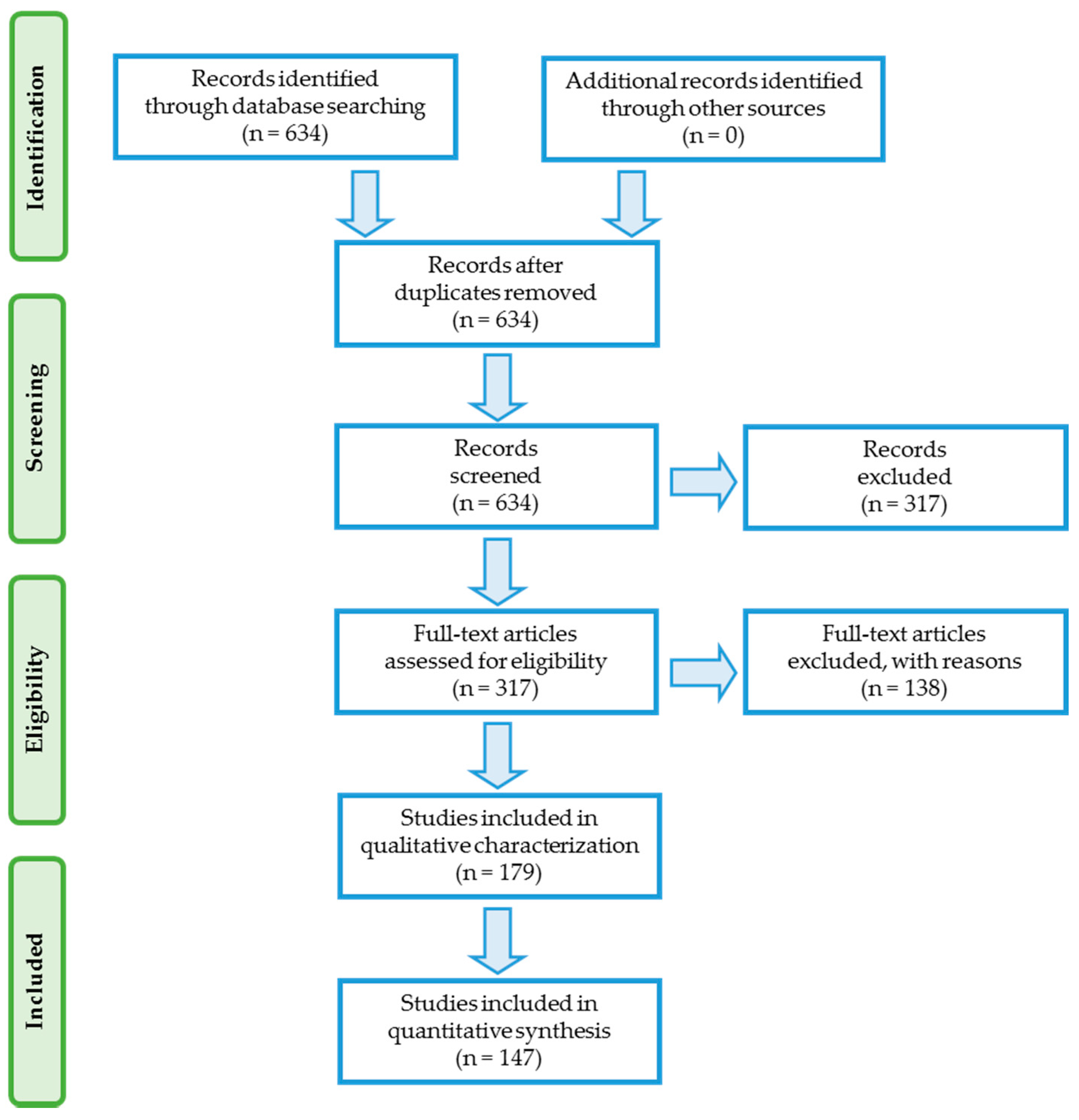
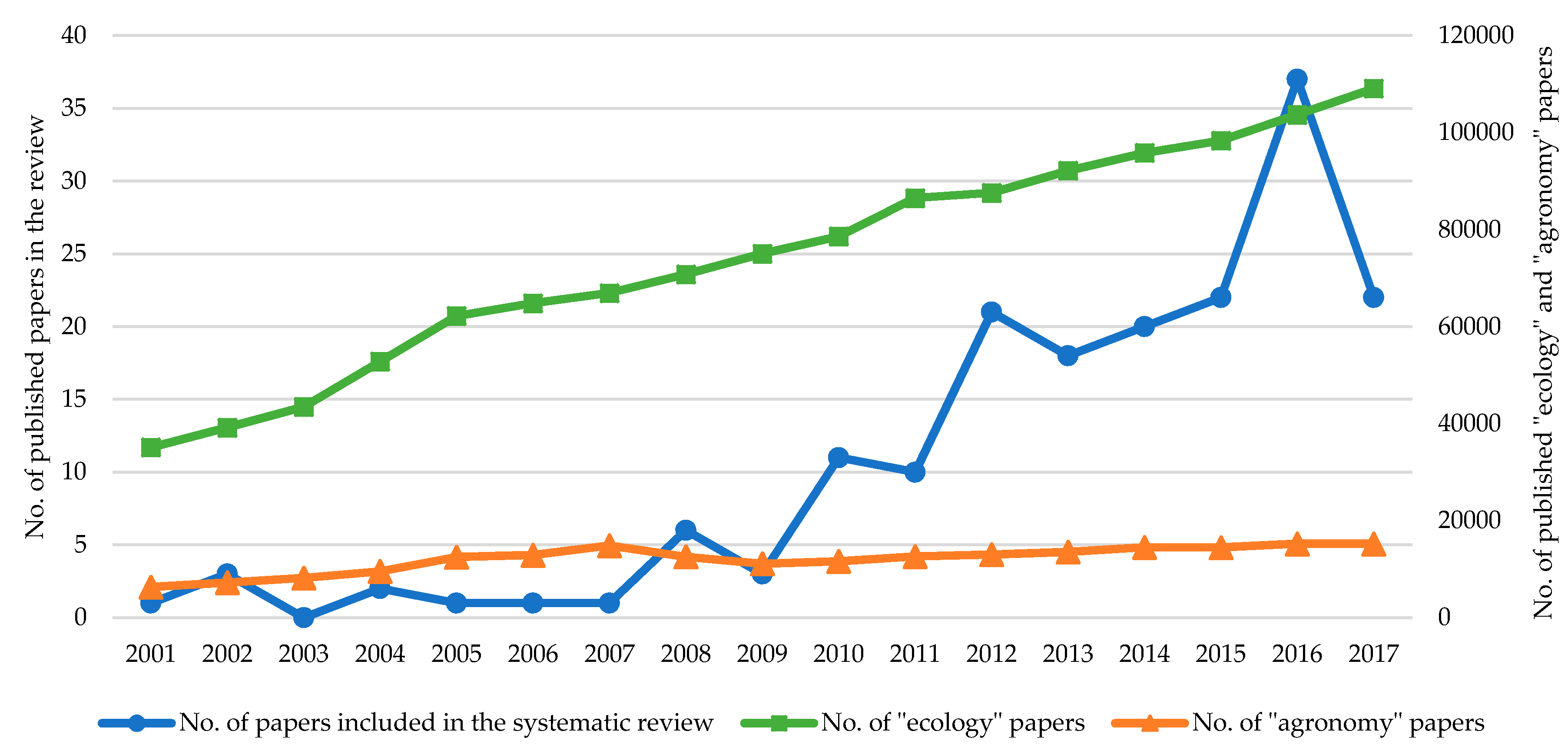
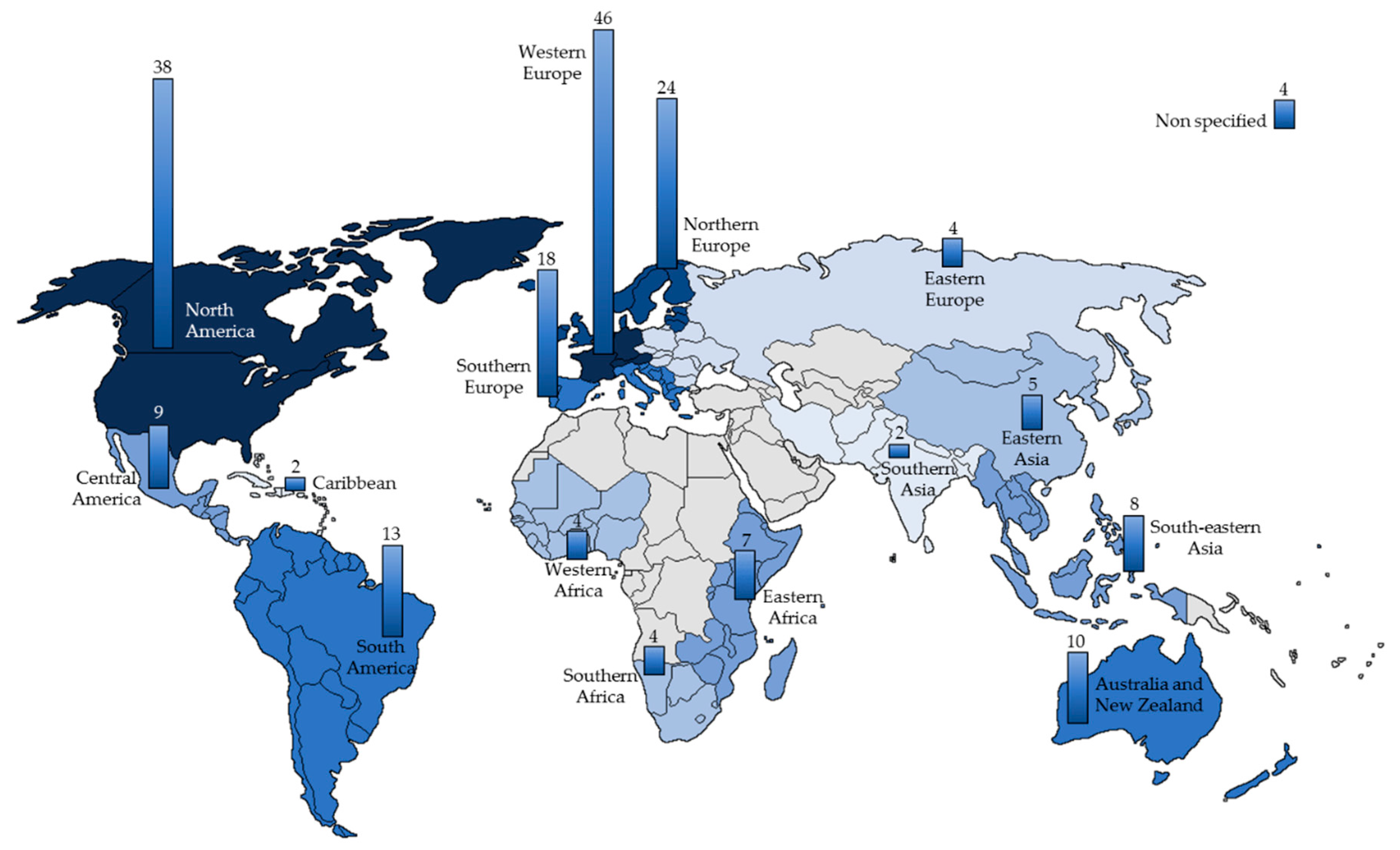
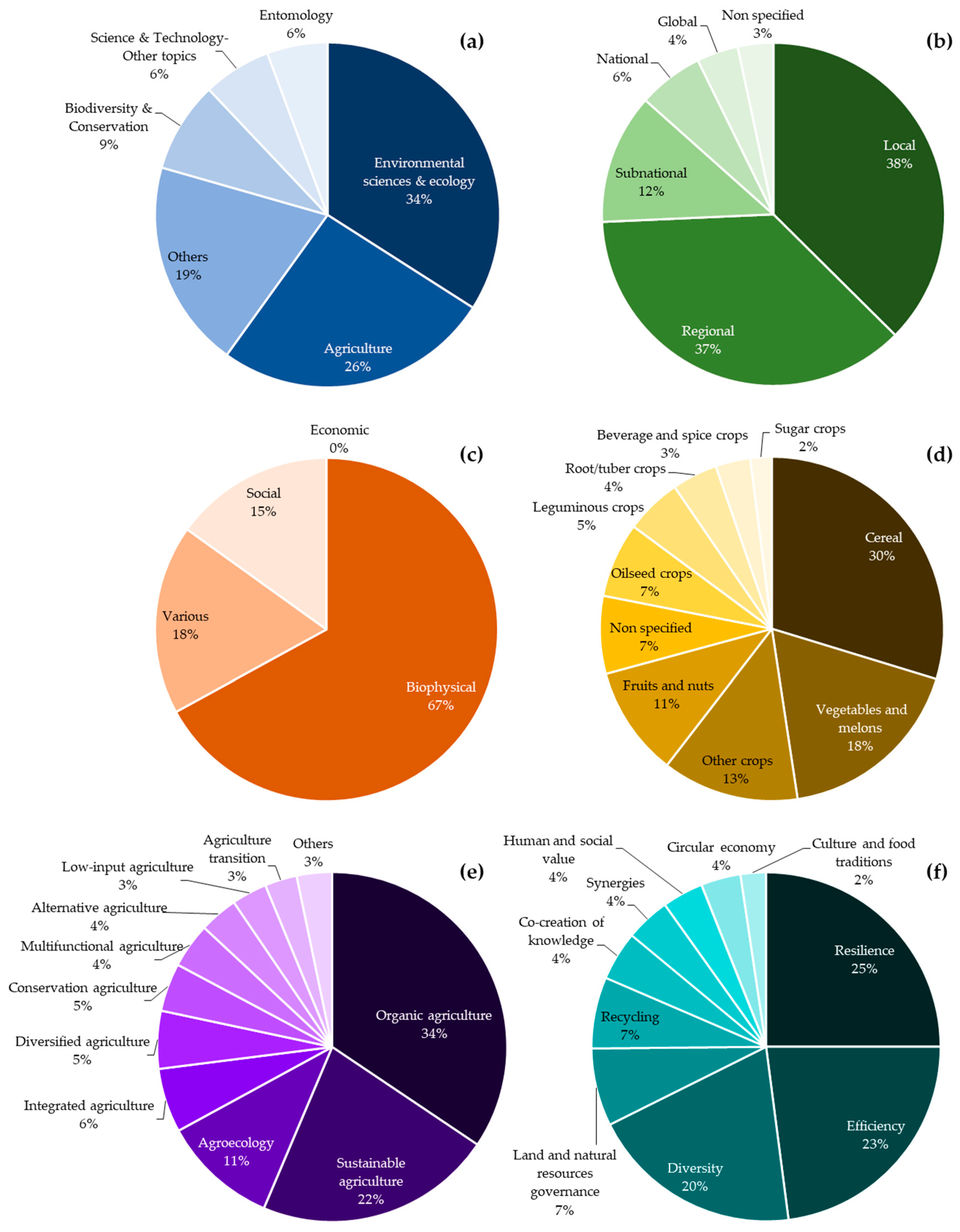
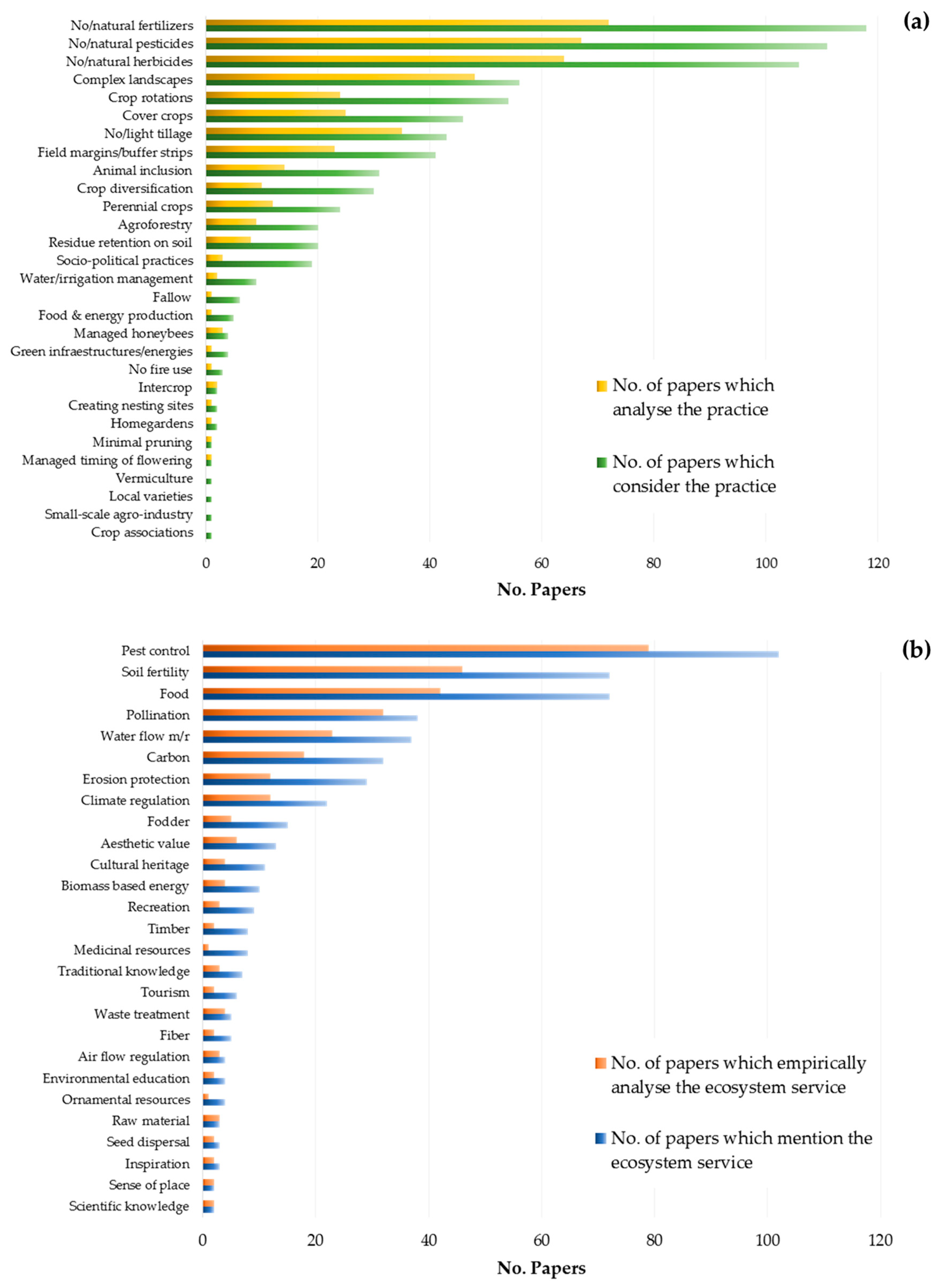
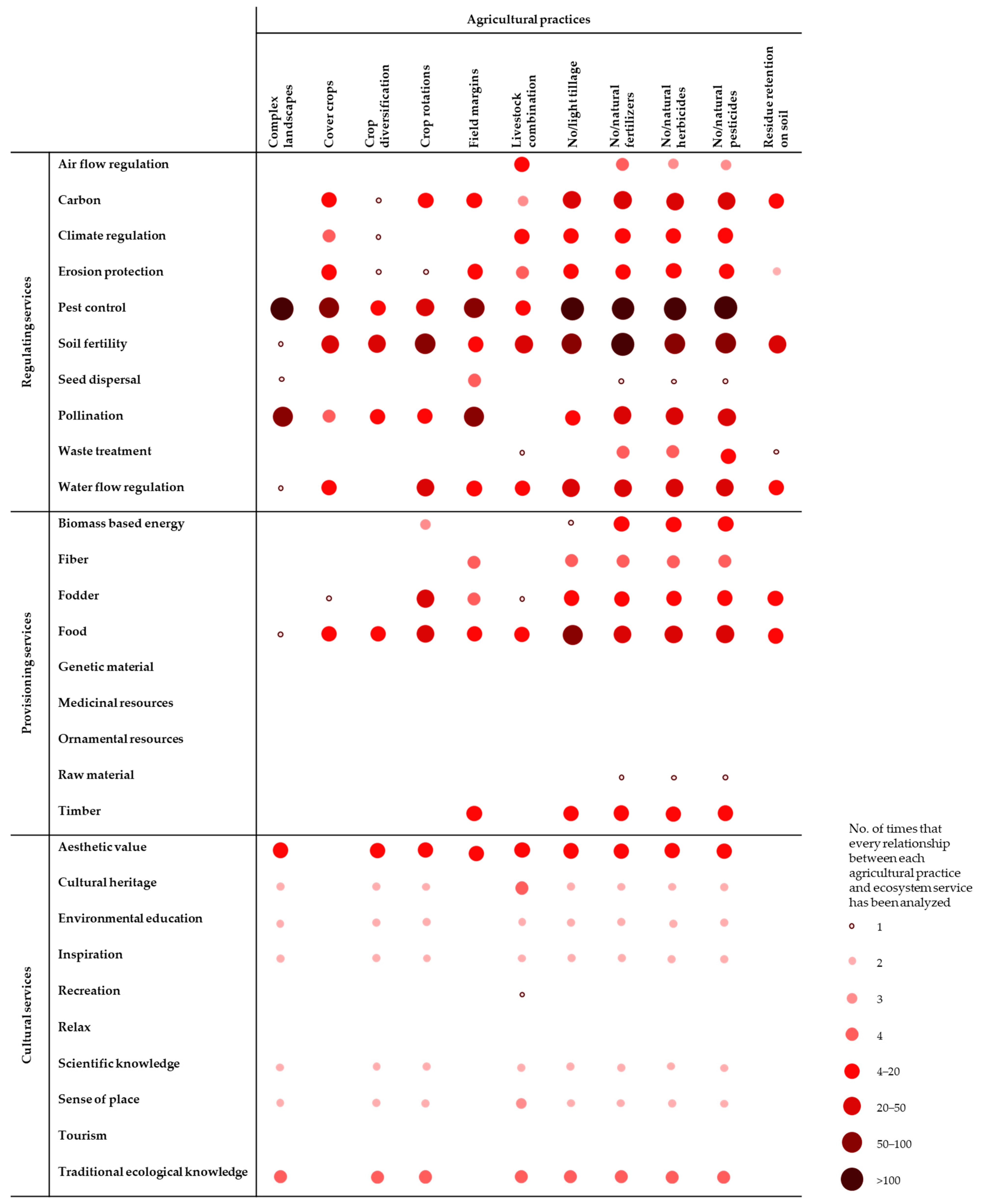
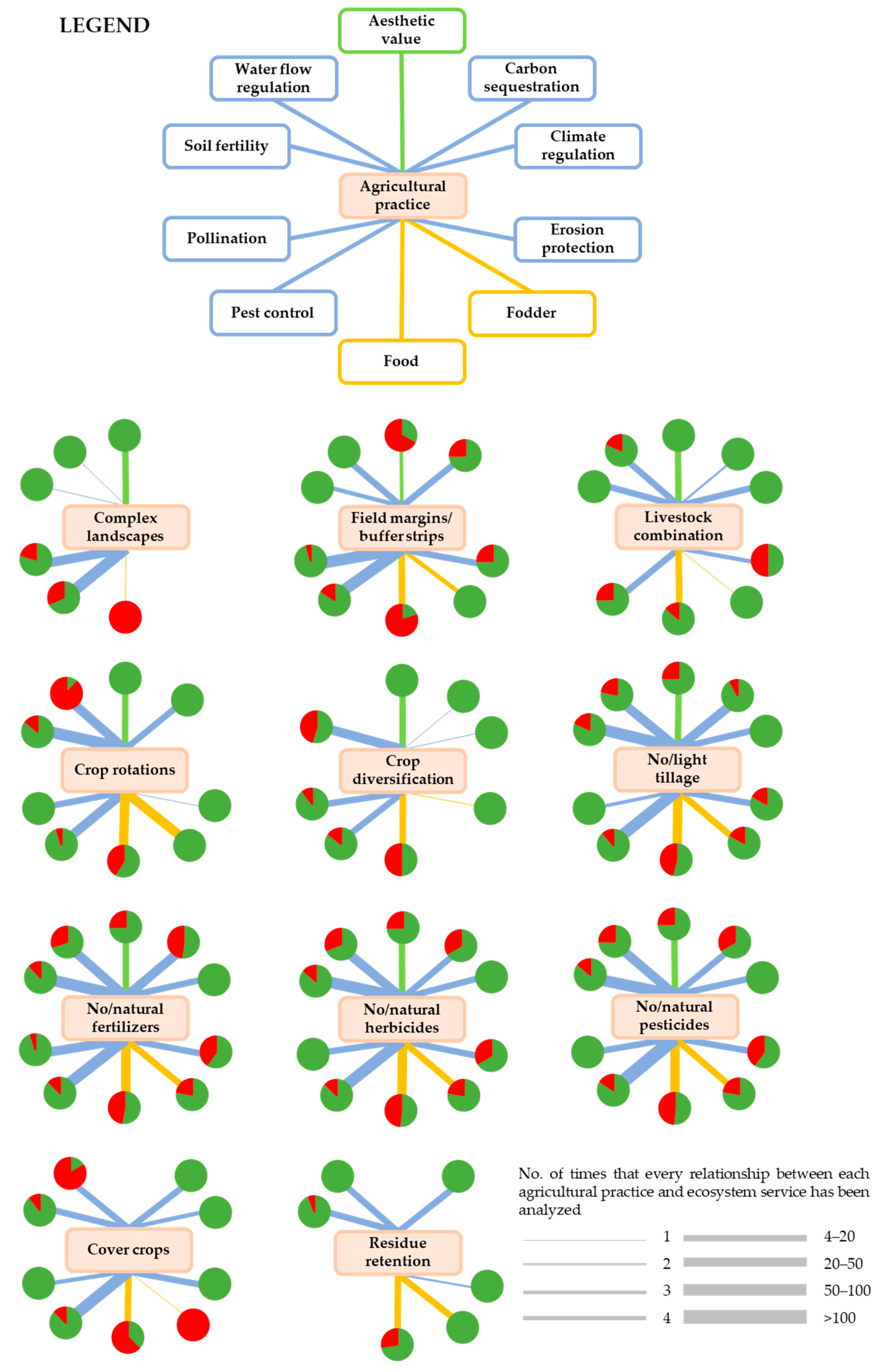
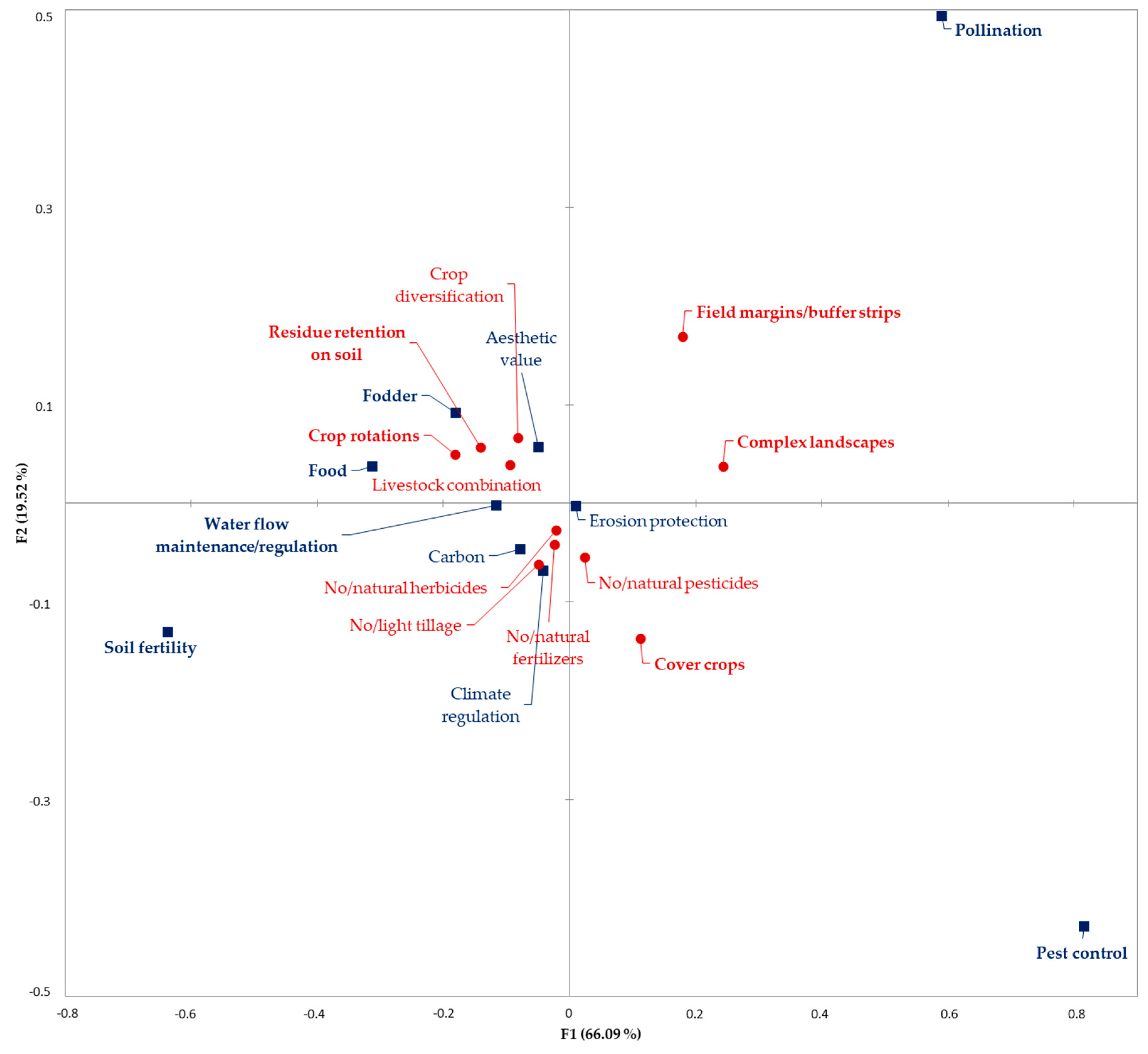
© 2018 by the authors. Licensee MDPI, Basel, Switzerland. This article is an open access article distributed under the terms and conditions of the Creative Commons Attribution (CC BY) license (http://creativecommons.org/licenses/by/4.0/).
Share and Cite
Palomo-Campesino, S.; González, J.A.; García-Llorente, M. Exploring the Connections between Agroecological Practices and Ecosystem Services: A Systematic Literature Review. Sustainability 2018, 10, 4339. https://doi.org/10.3390/su10124339
Palomo-Campesino S, González JA, García-Llorente M. Exploring the Connections between Agroecological Practices and Ecosystem Services: A Systematic Literature Review. Sustainability. 2018; 10(12):4339. https://doi.org/10.3390/su10124339
Chicago/Turabian StylePalomo-Campesino, Sara, José A. González, and Marina García-Llorente. 2018. "Exploring the Connections between Agroecological Practices and Ecosystem Services: A Systematic Literature Review" Sustainability 10, no. 12: 4339. https://doi.org/10.3390/su10124339
APA StylePalomo-Campesino, S., González, J. A., & García-Llorente, M. (2018). Exploring the Connections between Agroecological Practices and Ecosystem Services: A Systematic Literature Review. Sustainability, 10(12), 4339. https://doi.org/10.3390/su10124339





